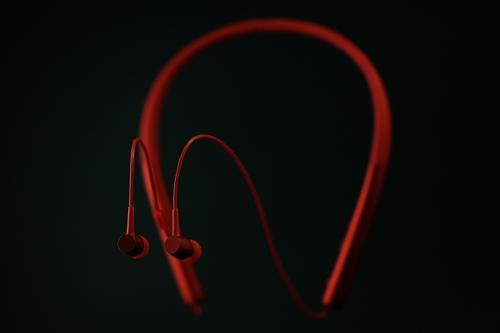: Comfort, LDAC/ Bluetooth Connectivity, Battery Life
: Sound Signature, Active Use, Design
SONY H.EAR IN WIRELESS
A Different Bluetooth Headphone

The Latest In The h.ear Series
The Sony h.ear in Wireless (sic) is a refreshing product from Sony in the realm of the general consumer audio market. Like the h.ear on/ h.ear in, the h.ear in Wireless represents the latest in a vastly updated Sony product line. Gone are the boring business professional designs from yesteryear. Instead, welcome an eccentrically catchy design that features just enough “hip” colors to impress even your most judgmental high-school student. Cinnabar Red, anyone?
Capitalization and punctuation were the first casualties of this review. The wordplay in the product name, while being incredibly striking and edgy, made it both difficult to read and edit properly. Luckily, the ominous product number (MDR-EX750BT) made a return to rescue my inner Connor from an angry Robert Patrick (Microsoft spellcheck). In the subsequent iterations of this review, “h.ear in Wireless” was edited out in favor of the clunky but grammatically sound “MDR-EX750BT”. Apologies to those who were expecting an easy read.
In all seriousness though, I would like to thank Sony for helping to coordinate this review, and for putting up with my hectic and constantly changing schedule. The uniform professionalism of the team here has always impressed me, and it has been a pleasure reviewing the MDR-EX750BT. The usual review disclaimer follows below.
Disclaimer
The MDR-EX750BT was provided by Sony for the purposes of this review. I have now had it on loan for close to 3 weeks. I am neither a paid affiliate nor an employee of Sony. I do reserve the rights to this media, so do contact me if you wish to reproduce any part of the writing or photography seen here. Review can also be found here on my site.
PACKAGING/ ACCESSORIES
Opening up the fairly standard matte box reveals another nicely colored box with the headphones inside. Sony is still a master of industrial product packaging, always striking a nice balance between economy, style, and practicality. Flipping open the front flap, one encounters the MDR-EX750BT encased within white blister packaging. Removing the blister package reveals the included accessories, which are listed below:
- Micro-USB cable (charging, 50cm)
- Hybrid Silicone Rubber Earbuds (5 pairs, 2 x large)
- Dedicated headphone cable (1m)
- Carrying pouch (not included in my package)
- Shirt clip (not included in my package)
Overall, a fairly complete product package. The extra pair of large tips was certainly a well-considered move. However, the one thing the MDR-EX750BT could have really used was a carrying case. If the budget Beyerdynamic DTX-501P can come with a hard-shell EVA case, I don’t see the inherent difficulty in including one for the pricier and more delicate MDR-EX750BT. Hard pouches are really a necessity for portable items, and it would be nice to see more manufacturers include these.

Both the h.ear on headphones and h.ear in earphones were classy and elegant in an understated way. The MDR-EX750BT is quite something else. Primarily comprised of two components – a neckband and the earphones (or headphones, depending on how you choose to see it), the MDR-EX750BT is remarkably comfortable for static use. The neckband is covered in soft rubber at key contact points, while the rest is plastic painted in a metallic color of your choice. Two thin wires connect the two key components together. Overall, a little light in the hand, but quite comfortable.
However, there are some practical concerns with the design. There is no strain relief where the wire exits the neckband, so I suspect cabling issues may arise in the long-term. The neckband is also unsuitable for active use (i.e. running) as it will bounce up and down uncomfortably on one’s collarbone. And finally, we arrive at the elephant in the room. The design itself. It looks good in theory, but in terms of real life execution it just didn’t quite work out for me. I had friends ask me if I was wearing a hairband (I’m a guy), and this did make use in social settings a bit awkward. I feel like one could get away with the black version, but it simply doesn’t look particularly smart or wieldy. However, it’ll be up to the individual to decide if this makes a good lifestyle accessory.
A slight note on usage. When turning on the headphones, hold the power button for about 10 seconds. The initial flashing blue light is deceptive and doesn’t actually put the unit into the Bluetooth sync mode. Just a heads up as this did cause me some problems until I was duly informed by the extremely patient Sony representative. NFC connection can be done by putting a compatible device near the right stem. Overall, a painless and intuitive system.







